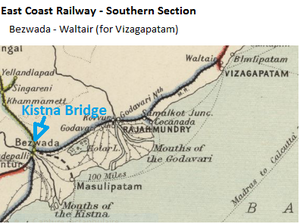Difference between revisions of "Kistna Bridge, Bezwada(ECR)"
(Map added and new info) |
(Map and added information) |
||
| Line 19: | Line 19: | ||
The bridge was designed by Sir [[Alexander Meadows Rendel|Alexander Rendel]] and [[Francis Joseph Edward Spring|F J E Spring]] as Engineer-in-Chief, and [[Ernest Ifill Shadbolt]] as Executive Engineer on construction. . The truss spans are built of plate girders and were fabricated in Britain, half by P & W MacLellan and half by Head Wrightson Co. | The bridge was designed by Sir [[Alexander Meadows Rendel|Alexander Rendel]] and [[Francis Joseph Edward Spring|F J E Spring]] as Engineer-in-Chief, and [[Ernest Ifill Shadbolt]] as Executive Engineer on construction. . The truss spans are built of plate girders and were fabricated in Britain, half by P & W MacLellan and half by Head Wrightson Co. | ||
<ref>[http://pubs-newcomen.com/tfiles/72bp179s.pdf “Bridge Building Achievements of P & W MacLellan & Co (1850-1914) by Michael Moss and John Hume, page 192]; Retrieved on 1 May 2016</ref> | <ref>[http://pubs-newcomen.com/tfiles/72bp179s.pdf “Bridge Building Achievements of P & W MacLellan & Co (1850-1914) by Michael Moss and John Hume, page 192]; Retrieved on 1 May 2016</ref> | ||
| + | |||
| + | The ‘Kistna Bridge” comprised twelve 300 foot(9.1mtr) spans and was constructed with as a broad gauge([[Rail_gauge#Broad_Gauge|BG]]) line. At some time an additional rail was added to allow metre gauge([[Rail_gauge_#Metre_Gauge|MG]]) traffic to use the bridge <ref name=ICE1946>[https://www.icevirtuallibrary.com/doi/abs/10.1680/ijoti.1946.13744 Journal of the Institution of Civil Engineers, Volume 26 Issue 7, May 1946, pp. 403-405 “The re-flooring of the Kistna and Godavari Bridges on the Madras and Southern Mahratta Railway “by D.H.McPherson]; Retrieved 26 Nov 2020</ref>. This would be to accommodate the ‘[[Bellary-Kistna State Railway]]’ metre gauge([[Rail_gauge_#Metre_Gauge|MG]]) line. | ||
==Later History== | ==Later History== | ||
In 1901 the southern section of the ‘[[East Coast State Railway]]’ - which included the ‘Kistna Bridge’ - was transferred to the ‘[[Madras Railway]]’(MR) in 1901; subsequently renamed ‘[[Madras (North-East) Railway]]’; becoming the [[Madras-Waltair NE Mainline]] of the ‘[[Madras and Southern Mahratta Railway]]’(M&SMR) in 1908. | In 1901 the southern section of the ‘[[East Coast State Railway]]’ - which included the ‘Kistna Bridge’ - was transferred to the ‘[[Madras Railway]]’(MR) in 1901; subsequently renamed ‘[[Madras (North-East) Railway]]’; becoming the [[Madras-Waltair NE Mainline]] of the ‘[[Madras and Southern Mahratta Railway]]’(M&SMR) in 1908. | ||
| + | |||
| + | In 1946 there was complete ‘re-flooring’ of the bridge by replacing the wooden longitudinal and wooden sleepers with a steel system <ref name=ICE1946/> | ||
== References == | == References == | ||
Latest revision as of 16:18, 26 November 2020
Kistna Bridge, Bezweda(ECR)
To avoid confusion Fibis have adopted the following titles:-
- ‘Kistna Bridge, Bezweda(ECR)’ the subject of this page
- ‘Kistna Viaduct, Raichur’(GIPR)
The Kistna Bridge crossing the +Kistna River+ at +Bezwada+ opened in the early 1890’s. [1]
Spelling Note +Note+
- Bezwada is the older name for Vijayawada city in Andhra Pradesh, India
- River Kistna is now known as the Kristna River
The Bridge
The bridge over the River Kistna formed part of the broad gauge(BG) ‘East Coast State Railway’ and connected that line to ‘Nizam's Guaranteed State Railway’ system north of the River Kistna. It also provided an interchange with the metre gauge(MG) ‘Bellary-Kistna State Railway’ south of the river.
The bridge was designed by Sir Alexander Rendel and F J E Spring as Engineer-in-Chief, and Ernest Ifill Shadbolt as Executive Engineer on construction. . The truss spans are built of plate girders and were fabricated in Britain, half by P & W MacLellan and half by Head Wrightson Co. [2]
The ‘Kistna Bridge” comprised twelve 300 foot(9.1mtr) spans and was constructed with as a broad gauge(BG) line. At some time an additional rail was added to allow metre gauge(MG) traffic to use the bridge [3]. This would be to accommodate the ‘Bellary-Kistna State Railway’ metre gauge(MG) line.
Later History
In 1901 the southern section of the ‘East Coast State Railway’ - which included the ‘Kistna Bridge’ - was transferred to the ‘Madras Railway’(MR) in 1901; subsequently renamed ‘Madras (North-East) Railway’; becoming the Madras-Waltair NE Mainline of the ‘Madras and Southern Mahratta Railway’(M&SMR) in 1908.
In 1946 there was complete ‘re-flooring’ of the bridge by replacing the wooden longitudinal and wooden sleepers with a steel system [3]
References
- ↑ “Coolies, Capital and Colonialism: Studies in Indian Labour History” by Rana P. Behal, Marcel van der Linden, page 105; Retrieved on 1 May 2016
- ↑ “Bridge Building Achievements of P & W MacLellan & Co (1850-1914) by Michael Moss and John Hume, page 192; Retrieved on 1 May 2016
- ↑ 3.0 3.1 Journal of the Institution of Civil Engineers, Volume 26 Issue 7, May 1946, pp. 403-405 “The re-flooring of the Kistna and Godavari Bridges on the Madras and Southern Mahratta Railway “by D.H.McPherson; Retrieved 26 Nov 2020
